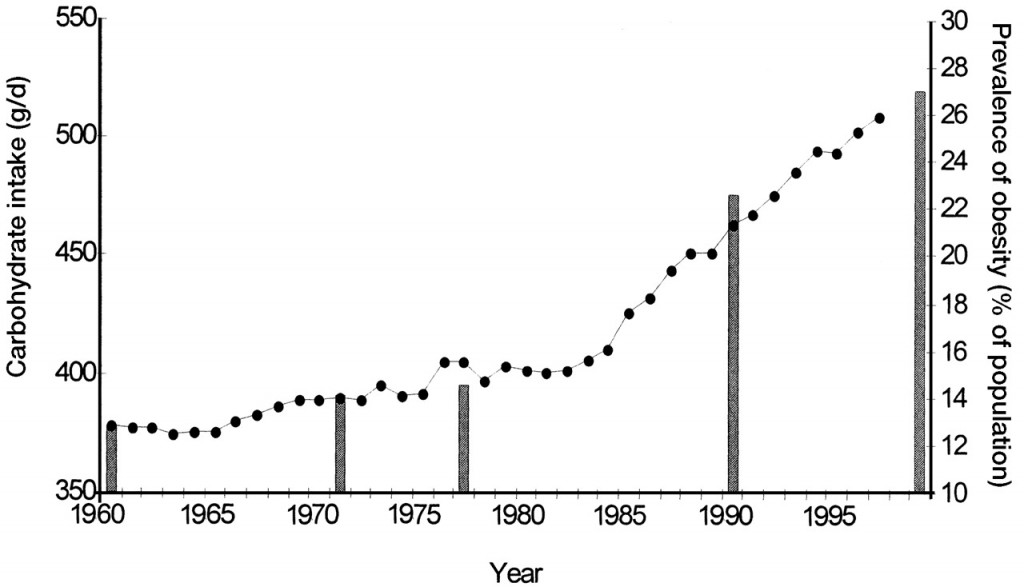 I’m going to apologize ahead of time for this big-as* long post, but people have questions – especially those people with big as*es, who are doing everything “right,” according to following the US dietary guidelines and are frustrated as heck.
I’m going to apologize ahead of time for this big-as* long post, but people have questions – especially those people with big as*es, who are doing everything “right,” according to following the US dietary guidelines and are frustrated as heck.
This isn’t a short answer and the history has to be explained in order to understand why and how we have all been so misled, so hence the need for this big as* long post.
I hope to educate those who want to know why our country (and those countries who have followed our lead) have exploded in their obesity rates since the 1980s. Although obesity rates have risen, so have solutions to combatting unwanted fat, such as lipo laser machines (http://www.usalipolasers.com) which many are using with the goal of improving their health.
The controversy really heated up in 1972 when John Yudkin, a British professor of nutrition and the most prominent nutritionist in the UK, was the first to publicly sound the alarm on sugar back in 1972, and a book called “Pure, White, and deadly.” The book sold well, but Yudkin was quickly attacked by mainstream nutritionists and the food industry, who teamed up to destroy his reputation. Because of their power and influence, they succeeded – starting even before that, which I will get to here.
This mainstream influence is responsible for making fat the villain over the last several decades. Ever since the low-fat diet has been espoused as the healthy way to eat, our country has gotten fatter and sicker.
In 1980, the mainstream convinced our government to issue its first dietary guidelines. Doctors mindlessly started promoting it and food companies began to develop their processed foods around it. Now the influence has spread worldwide, and every country who adopts these guidelines gets sicker and fatter.
The main recommendation was to cut back on saturated fats and cholesterol. Before this, the recommendations were to eat more of certain things ? not less of something. Regardless, the populace bought it hook, line and sinker and so did I. And it didn’t work for them or for me. Just like everyone else, I replaced meat with pasta, bread and other starches. I chose margarine over butter. Low-fat milk replaced whole milk on my grocery list and fruit juice was added to that list.
If you look at the graph of obesity rates above, you will see that in the early 1980s, the line takes off like an airplane, accelerated with the popularity explosion of the new invention of High Fructose Corn Syrup (HFCS). Nixon was facing re-election, but the cost of food was soaring. Nixon needed a quick fix and appointed Earl Butz to find a solution. Butz got farmers and their lobby on Nixon’s side by promising to help them scale up their production – especially with corn. Cattle started eating more of it and got fatter, which meant more money for those farmers too. Fried food in corn oil became more popular – and cheaper to buy. Corn became a main ingredient in many other processed foods too.
By the mid 70’s there was a surplus of corn because Butz push and government surpluses had pushed it too far. Butz flew to Japan to follow a lead he discovered might be able to use up more corn. Scientists there had developed a process to mass produce high fructose corn syrup (HFCS). Also at this time, sugar prices were increasing, so a cheaper alternative like HFCS could solve that problem too. Butz brought it to the USA and it was soon pumped into numerous processed foods and beverages. Plus, it extended the shelf like of processed foods from days to years.
By the mid 80’s, health experts were noticing that people were getting fatter and no one could figure it out. Even those who eat low fat and exercise are still gaining weight. Less than 10% of Americans were obese before World War II. 15% were obese in 1980, and that rate shot up after that, so now more then one third of the US is overweight or obese.
Something else was going on that was just as strange. The more HFCS we ate, the hungrier we became. Anthony Sclafani, a researcher at NY University, noticed that when his lab rats ate rat food, they put on weight normally. But when they ate processed food with HFCS, they ballooned up in a matter of days and their appetite was insatiable. The processed food industry knows this, but they don’t mind because it means more profit for them.
In the UK, things lagged behind by about five years because that’s how long it took for our mistakes and misinformation to spread to that country. Only 6% of the people in the UK were obese in 1980. By the year 2000, that figure more than tripled. Today, more than two thirds of Britains are overweight, with many of them being obese. Diabetes has also risen parallel to the obesity rate lines on that chart and the same is true for the US and all other countries poisoned by our low-fat recommendations.
Instead of admitting they were wrong, the mainstream has chosen to blame the individual instead, claiming they are simply eating more than they used to and exercising less. In other words, the reason for the pandemic explosion in obesity, diabetes and heart disease is due to the fact that everyone has suddenly become lazy gluttons since 1980. This, in spite of the fact that we are exercising and dieting more than ever.
Now let’s take a look at how it all began. On September 23, 1955, US Presisdent Dwight Eisenhower had a heart attack. The next day, Dr. White, his chief physician, gave a press conference, which he turned into a lesson on how to avoid heart disease. He recommended everyone stop smoking and cut down on fat and cholesterol. Most Americans bought it, but several smart people questioned it, wondering how Dr. White was making recommendations based on personal assumptions gathered from one person, without any research or science to back it up.
Dr. White scrambled to bolster his credibility for his statements and scrounged up some “research” from a nutritionist at the University of Minnesota named Ancel Keys, who seemed to agree with Dr. White’s claims. This was a boon for Keys and effectively put him in the spotlight. All this publicity created a public scare about heart disease and Keys (already in the spotlight and loving it) eagerly stepped up to the plate, providing his “diet ? heart hypothesis.” Keys claimed that saturated fats were doomed to collect on the walls of arteries, causing them to harden and narrow, until the blood stops flowing, resulting in a heart attack.
Keys was intelligent, charismatic and aggressively attacked anyone who disagreed with his point of view. Even Eisenhower’s death from heart disease in 1969 didn’t phase Keys. He had the public limelight, the momentum and was on a roll that he was enjoying immensely. Fame, fortune and influence followed him and he took to it like a duck to water.
At this time, John Yudkin was still the UK?s leading nutritionist. When Yudkin looked at Keys recommendations and the data on heart disease, he saw no correlation with fat, but he did see an extremely strong correlation with sugar. He conducted numerous laboratory experiments on the subject and found without a doubt that sugar was indeed the culprit – not fat. Yudkin also made the common sense observation that humans have been consuming fat since the beginning of our existence. In fact, every human still consumes fat at the beginning of their existence, through their mother’s milk, which incidentally, is high in saturated fat and cholesterol.
Carbohydrates on the other hand, have only been around for about 5000 years (in significant quantities among various populations), thanks to the the invention of mass agriculture. Sugar, a pure carbohydrate, with all fiber and nutrients stripped out, has only been a part of modern diets for about 300 years. Yudkin supposed that the new kid on the block ? sugar ? was more likely to be the cause of heart disease than saturated fat, which has been around as long as humans have.
Keys, the most prominent US nutritionist, was quite aware of Yudkin?s opposition because it threatened his growing empire and notoriety. If Yudkin published a paper, Keys would discredit it and aggressively attack Yudkin, calling his reports ?a mountain of nonsense,” and accusing him of being in bed with the meat and dairy industries. Yudkin never participated in the mud slinging though, because he was a kind, gentle man, who had no desire for political combat.
Keys quickly won over the British Sugar Bureau, who of course was already motivated to align with Keys, since their profits would increase with Keys on their side. With this combined influence, Yudkin began to slide in his credibility. Within just 10 years, Yudkin?s reputation had been destroyed. He found himself uninvited from international conferences and research journals refused his papers. Eventually, he became a laughingstock and largely forgotten.
Throughout the 60s, Keys formed many more powerful alliances among the most influential organizations in healthcare and the food industry. From 1958 to 1964, Keys and his team of researchers gathered data from seven select countries to back up his hypothesis. What people didn’t know then (because Keys and his minions kept it top-secret), was that his ?Seven Countries Study” had more holes in it than grandma’s kitchen colander. It was the epitome of “junk science.” Keys even went so far as to pick the seven countries that did support his hypothesis, while omitting all of the countries that showed opposite results to his hypothesis. Keys also based his hypothesis on correlation causing causation, which in the scientific community, is the first indicator of junk science.
Smart people complained about this correlation/causation, so Keys and his minions attempted to create laboratory trials to support his hypothesis, but every single one failed. Recently, one of these studies was discovered and hit the mainstream. It was found in the basement of one of his deceased colleagues. The conclusions were exactly opposite of keys hypothesis, so the study was censored and relegated to a file cabinet. http://well.blogs.nytimes.com/2016/04/13/a-decades-old-study-rediscovered-challenges-advice-on-saturated-fat/?_r=0
Years later, the Seven Countries study?s lead Italian researcher, Alessandro Menotti, went back to the data and found that the food which correlated most closely with deaths from heart disease was not saturated fat after all, but sugar. By then it was too late though. Key’s bogus study had become the gospel truth and a congressional committee chaired by Sen. George McGovern had already created the national advice to eat low-fat and especially avoid saturated fat and cholesterol. Yudkin was called before a committee and asked point blank by McGovern if he was really suggesting that a high fat intake was not a problem and that cholesterol presented no danger. Yudkin of course replied yes to both and McGovern answered with, ?That is exactly the opposite of what my doctor told me.” So based on the “knowledge” of his family doctor, McGovern disregarded Yudkin’s claims, despite the fact that he was the most prominent nutritional scientist and researcher in the UK at the time, although on the slide, thanks to Keys – who was close buddies with McGovern. Many think that McGovern called him to the public eye specifically to finish him off and complete the process of destroying his credibility.
Now the truth is slowly coming out – that Yudkin was right and Keys was “dead” wrong. Sugar is indeed the villain and fat is actually the hero. Sugar is a refined carbohydrate completely devoid of all nutrients. In fact, sugar and all other carbohydrates aren’t even an essential nutrient to humans. Without it, we can live just fine. Fat on the other hand, has numerous beneficial nutrients and is essential. Our liver can’t make enough on its own to keep us alive, so without eating it, we die.
Keys is dead now, so I guess the quote from physicist Max Planck is true: “A new scientific truth does not triumph by convincing its opponents and making them see the light, but rather because it’s opponents eventually die, and a new generation grows up that is familiar with it.”
Keys theories seemed to made intuitive sense to many because after all, if fat and cholesterol killed Eisenhower, shouldn’t we stay away from them? The fundamental error here was the confusion between what a person puts in their mouth and with what it becomes after it’s swallowed. The human body transforms food into nutrients it can use now, or store for later. Cholesterol, for instance, is present in every single one of our cells and it’s created by the liver. It’s a known fact that the more cholesterol you eat, the less your liver has to produce. This is why eating high amounts of cholesterol doesn’t significantly raise blood cholesterol levels.
This is one of the reasons why modern health authorities have started backing away from this colossal nutrition guidance blunder. They are doing it slowly though, because if they all came out at once, admitting they were wrong, they would basically have to say, “Sorry everyone, for making you fat, sick and killing millions of you.? Think of the public stampede from an admission like that, let alone the credibility rebellion, rendering the government’s recommendations on anything, ever again, completely worthless.
Still today, the majority of US doctors continue to believe that dietary cholesterol raises blood cholesterol. Most doctors don’t do any research of their own. They just repeat what they’ve been taught in medical school and what the mainstream is feeding them. Progressive doctors on the other hand, who have open minds and spend time researching things for themselves, (like Dr. Mercola for instance), are actually able to help people get healthier and leaner instead set of sicker and fatter.
Hundreds of studies over the last 50 years have shown sugar to be the villain, not fat. The evidence is simply overwhelming. Gary Taubes book, ?Good Calories, Bad Calories? is one of the best references to these studies. Taubes?s second book, ?Why We Get Fat? is much easier to read and understand than his first, more clinical book. Still, even today, most mainstream nutritionists (who don’t do their research) refuse to accept the truth. It’s quite hard for someone to admit they are completely wrong and that they should have been counseling their patients and clients in the opposite direction all along. After all, at first glance, it does make “intuitive” sense that fat would make you fat. Plus, fat has more than twice the calories of sugar per gram, that can seem to be confirmation of the misinformation.
The whole calorie in/calorie out theory is also fatally flawed and completely wrong. Obesity is really more of a hormonal disorder, triggered by the kinds of calories we eat instead of the total calorie count itself. Sugar sends those hormones completely out of whack, out of ratio, and out of range. Fat on the other hand, brings them back into the healthy range.
Sugar also destroys the good to bad ratio of gut bacteria, which in very recent studies has been shown to be arguably the largest cause of obesity because of their effect on metabolic hormones and organ function. Another great book that addresses this topic is “The Calorie Myth” by Johnathan Bailor. My favorite book though, is “Cracking Your Calorie Code,” written by another voracious researcher, yours truly.
A recent best seller on the topic, “The Big Fat Surprise” by Nina Teicholz, has created enough of a stir that a Congressional review panel has been formed to revisit the topic of official dietary guideline recommendations. In September 2015, she wrote an article for the British Medical Journal that flared tempers among scientists who were unwilling to backtrack. They actually requested that BMJ retract and censor the article. Journal retraction is only reserved for cases involving fraudulent data though, so when the scientists who sent the letter of retraction were questioned on the supposed errors, none of them were able to list even one. They were quick to point out however, that Teicholz lacks credibility because she is not a scientist. Neither is Gary Taubes, but maybe that?s why Gary and Nina are so right and the close-minded ?scientists? and so very, very, wrong.
Some other great books on the subject are from actual doctors, like Dr Hyman who wrote “Eat Fat Get Thin,” Dr. Lustig, who wrote “Fat Chance,” and Dr. Ludwig, who wrote “Always Hungry?” These doctors are saying the same thing as the researchers and journalists listed above.
What’s the bottom line? Eat LOTS of fat first, GOBS of green vegetables second, moderate protein third, low to no carbohydrates (in the form of starchy foods) and ZERO sugar. Easier said than done? Yep, but I’ve got some short cuts for you and you will find them in my personal blog at pjfit.com.









